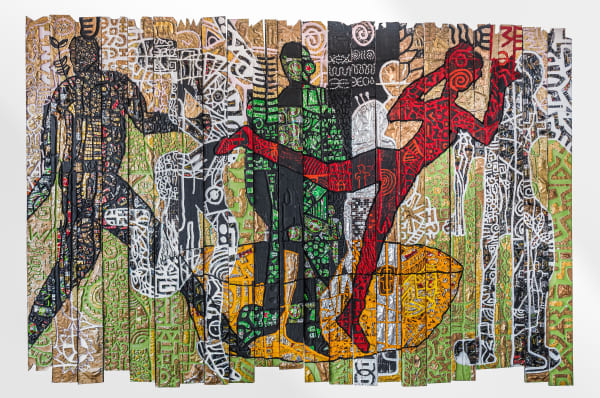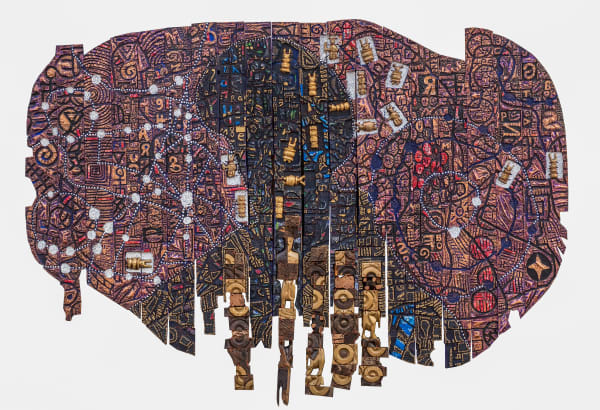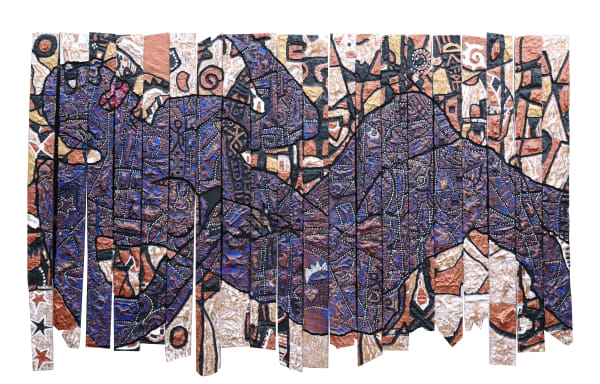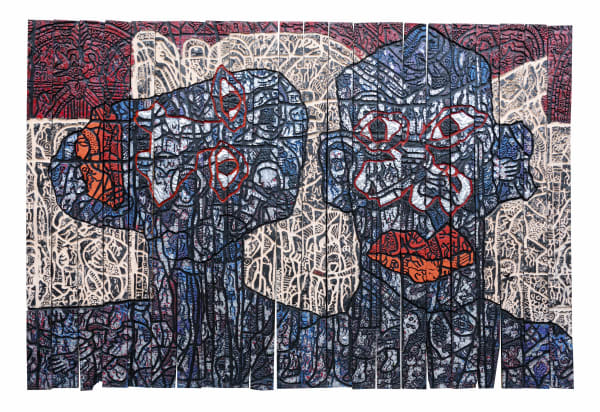-
Eclipse of the Scrolls
-

-

-
Enquire
-
 Gerald Chukwuma, ROCK THE BOAT BABY, 2021
Gerald Chukwuma, ROCK THE BOAT BABY, 2021 -
 Gerald Chukwuma, EFURU'S COMB, 2021
Gerald Chukwuma, EFURU'S COMB, 2021 -
 Gerald Chukwuma, FLY AWAY PITA FLY AWAY POL.... COME BACK PITA COM BACK POL, 2020
Gerald Chukwuma, FLY AWAY PITA FLY AWAY POL.... COME BACK PITA COM BACK POL, 2020 -
 Gerald Chukwuma, FLOWER GIRLS, 2021
Gerald Chukwuma, FLOWER GIRLS, 2021
-
-
-
This latest body of work brings together a number of Chukwuma’s concerns in relation to how media shapes our knowledge of not only history, but the present moment. Whilst the manipulation of media by dominating powers is not a new issue, recent national and global crises have provided fresh opportunities to direct public opinion. ‘If you watch the news in Nigeria, you only see footage of people dying of coronavirus in America or the UK, but why are Nigerians not dying? Can we say that we have immunity or the cure?’ says the artist. ‘It’s not about cutting off information, it’s about masking the truth.’ In a sub-series of smaller-scale works entitled Untold Stories, Chukwuma reimagines the covers of tabloid newspapers with symbols and headlines stitched onto the background whilst haunting black figures hang down from the centre, their facial features assembled from mechanical cogs, wheels and padlocks. This collage style is characteristic of the artist’s work, but the hybrid figures - half-man, half-machine - are especially powerful here as a reflection on how the information we are fed or denied impacts our cultural identities and wider sense of self.
For many years, Chukwuma’s practice has been deeply informed and inspired by the Uli art traditions of the Igbo people from southeastern Nigeria. However, through his research, the artist has discovered that Igbo culture has not been sufficiently documented, and as such, knowledge of their heritage is at risk of disappearing from contemporary consciousness. ‘A lack of data is a big problem in Africa,’ he says. ‘I am creating works that I hope can become a form of documentation.’ The Uli patterns and symbols were traditionally painted directly onto the skin or as murals on the walls of a house, which faded in the sunshine or washed away with the rain, but in Chukwuma’s artworks they are made permanent through various artistic processes and embedded within a multitude of references.
The artist incorporates materials that are sourced locally in Lagos and are typically regarded as everyday detritus, such as bottle corks and recycled soft drinks and beer cans. These are flattered and nailed onto the wooden panels, adding a new tactile dimension and contributing to the distinct colour palette as well as relating to contemporary discourse around waste and the environment. His aesthetic and colour palette, however, are influenced by his encounters with and studies of international art history such as Gustav Klimt’s gold detailing, Van Gogh’s complex use of colour and Picasso’s stylistic diversity. All of these experiences and observations manifest artistically as highly-textured surfaces and complex visual narratives that not only transcend time and geographical boundaries, but also materiality.
-
The incorporation of multiple voices and narratives is essential to Chukwuma’s artistic intentions, and also serves as a form of resistance to what he calls ‘the colonial implications of text’ and the prescribed role of the artist in Africa. ‘African societies thrived on oral traditions handed down from generation to generation, and these traditions, often sacrosanct as they were, could not withstand the cultural disruptions that were to be her colonial experience,’ he explains. ‘There are social implications to this impasse; one is the habitual place of the African creative in the global scheme of things. There is an unwritten place to which he seems to have been confined, and hardly permitted to operate beyond its stations. Often this social stratification is non-constitutional and does not have the backing of legal tenets in the actual sense, but rather works as a psychological cul-de-sac, a route with a finite and close ended destination, never to be surmounted.’
In an attempt to break free from such constraints, Chukuma embraces his ‘primordial instinct’ by working directly onto the wooden panels without making any preliminary sketches. ‘When it comes to my work, I tend to be open minded and very fluid,’ he says. ‘Perhaps my affinity with the Uli symbolism is with its fluidity and tactical use of space.’ This creative urgency and dynamism is perhaps most strongly felt in the heavily etched surface of the artwork entitled EFURU'S COMB. On a first glance, the writhing tangle of lines and colours is almost overwhelming, but gradually, the symbolism and imagery begins to reveal itself, offering a multitude of narrative possibilities that actively invite creative engagement and cultural exchange.
Melding together a bold mix of colours, artistic techniques, historic references, narratives and imagery, each artwork possesses an astounding sense of vitality and depth that celebrates creative expression and experimentation whilst also drawing our attention to how storytelling has been, and still is used as a tool of indoctrination. In this way, Eclipse of the Scrolls reminds us of how essential art is in challenging the status quo by making the untold stories of individuals, communities and nations visible to global audiences.
-
-
Gerald Chukwuma
Past viewing_room















